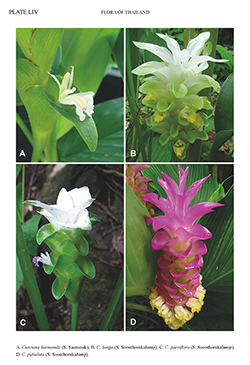e-Flora of Thailand
Volume 16 > Part 2 > Year 2023 > Page 452 > Zingiberaceae > Curcuma
36. Curcuma petiolata Roxb.wfo-0000365894
Fl. Ind. 1: 36. 1820. Plate LIV: D.
Accepted Name : This is currently accepted.
Synonyms & Citations :
Description : Rhizome branched, main rhizome ovoid, 3–5 by 5–8 cm, internally light yellow to yellow; branches short. Leafy shoot 35–120 cm tall with 3–7 leaves; bladeless sheaths decayed by anthesis, leaf sheaths green, densely puberulous to puberulent; ligule bilobed, 0.3–1(–2) cm long, semitranslucent green, sparsely pubescent; blades elliptic to broadly elliptic, 25–45 by 12–23 cm, prominently plicate, bright to mid green, glabrous on both surfaces or with a few hairs along secondary veins above, base cuneate to rounded to subcordate, apex acuminate; petiole 5–25 cm long, green, glabrous to puberulent. Inflorescence central; peduncle 20–40 cm long, mostly hidden within pseudostem, light green, densely puberulent; thyrse 13–30 by 6–8 cm, composed of 25–60 bracts; fertile bracts obovate with rounded and reflexed apex, 3.5–5.5 by 1.5–3 cm, green to whitish, with pink apex, puberulent on both surfaces; coma bracts elliptic with acute to obtuse apex, 4–6 by 1.5–2.5 cm, white to pale pink at base, pink to dark pink distally, pilose on both surfaces. Flower gullet type, 4–5 cm long; ovary barrel-shaped, ca 3 by 2 mm, cream, pubescent; epigynous glands cylindrical with rounded apex, ca 3 mm long, cream; style white, glabrous; stigma ca 1 mm diam., ostiole ciliate; calyx 8–9 mm long, with unilateral incision 3–4 mm long, apex tridentate, semitranslucent white, glabrous; floral tube narrowly cylindrical at base, funnel-shaped distally, 2–3 cm long, externally white to pale yellow, glabrous, internally with ring of dense, long hair internally, pale yellow and glabrous at base, bright yellow and hairy at constriction, pale yellow and with some glandular hair distally; dorsal corolla corolla lobe triangular with hooded, mucronate apex, 1.4–1.7 by 1–1.2 cm, white or with slight pink tinge, glabrous; lateral corolla lobes triangular with obtuse apex, 1.5–1.7 by 0.9–1.1 cm, slightly concave, white, glabrous; lateral staminodes oblong with obtuse to rounded apex, 1.1–1.3 by 0.6–0.8 cm, pale yellow, slightly darker distally, with sparse glandular hair above; labellum broadly ovate, obscurely trilobed, ca 1.2 by 1.5 cm, midlobe emarginate, sidelobes folded upwards, pale yellow at base, darker distally, with bright yellow median band extending to outer margin, glabrous, with sparse glandular hair along median band; stamen ca 6 mm long, filament concave, 3–4 mm long, ca 5 mm wide at base, ca 1.5 mm at point of attachment, white, glabrous; anther spurred, ca 6 by 2.5–3 mm, connective tissue white to pale yellow, glabrous, spurs conical, ca 2 mm long, white with pale yellow apex, anther crest bluntly quadrangular, concave, ca 1 by 1 mm, yellow, thecae ca 4 mm long, dehiscing throughout their length. Fruit globular to subglobular; seeds irregularly oblong to obovoid, brown with white laciniate aril.
Thailand : NORTHERN: Mae Hong Son, Phitsanulok; EASTERN: Chaiyaphum; CENTRAL: Lop Buri.
Distribution : Myanmar (type), Laos, Indonesia.
Ecology : Deciduous forests, 220–500 m alt. Flowering: June–August.
Vernacular : Bua chan (บัวชั้น).
Uses: Ornamental plant cultivated also for cut-flowers. Medicinally the stem and rhizome are used externally for wounds. It also forms part of the ingredients of steam baths.
Notes: This species produces the longest inflorescence of Thai Curcuma. The bracts with rounded apices and metallic pink colour distinguish it.

